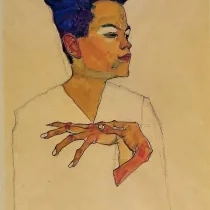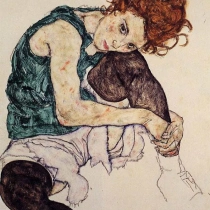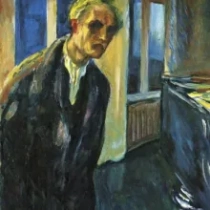 1890 - 1918
expressionism
1890 - 1918
expressionism
Description Egon Schiele
Egon Schiele, born in 1890, emerged from the Viennese avant-garde as a provocateur of the human form. Amid the gilded age of the Austro-Hungarian Empire, Schiele's art shattered societal norms. Trained at the Vienna Academy, he swiftly rejected academic conventions, embracing an expressive style that delved into the visceral realms of emotion.
Schiele's figurative distortions and contorted bodies challenged the ideals of beauty. His intense self-portraits, raw and unapologetic, mirrored the turmoil within. The artist's obsession with the human form, tinged with eroticism and vulnerability, laid bare the complexities of the human psyche.
The Viennese society, however, recoiled. Schiele's explicit nudes and candid explorations of sexuality sparked controversy. His imprisonment for obscenity did not deter him; instead, it fueled his determination to strip away societal veneers and expose the core of human existence.
A protege of Gustav Klimt, Schiele's art transcended the Secessionist movement. His solo path explored the darker corners of human relationships, often in stark contrast to the gilded decadence of the time. Works like "Death and the Maiden" and "The Embrace" captured the fragility of life and the haunting dance between love and mortality.
Tragically, Schiele's life was cut short at 28 during the 1918 influenza pandemic. His death marked the loss of a visionary who dared to challenge artistic and societal boundaries. Despite his brief existence, Schiele left an indelible imprint on Expressionism, inspiring subsequent generations with his unflinching exploration of the human psyche. In the twisted lines and poignant gazes of his figures, Schiele's legacy endures—a testament to the power of art to confront the uncomfortable truths that linger beneath the surface of human experience.
Gallery
Paintings Egon Schiele
Quotes
I must see new things and investigate them. I want to taste dark water and see crackling trees and wild winds.
Art cannot be modern. Art is primordially eternal.
I do not deny that I have made drawings and watercolors of an erotic nature. But they are always works of art. Are there no artists who have done erotic pictures?
To restrict the artist is a crime. It is to murder germinating life.
I do not feel punished, but I feel they've decided to repress me. They're fools. Unless they're haunted by what I do, I don't see how they can escape. My work is wholly autobiographical. It is about myself and my surroundings.
F.A.Q Section
"Self-Portrait with Physalis" (1912): A striking self-portrait showcasing Schiele's intense gaze and innovative composition.
"Portrait of Wally Neuzil" (1912): A portrait of Schiele's muse and model, known for its intimacy and psychological intensity.





No Comments Yet...